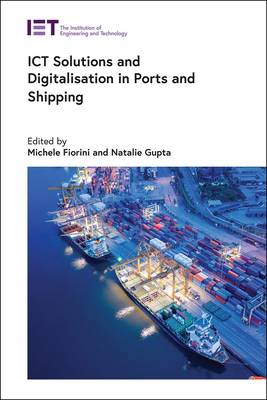
- Retrait gratuit dans votre magasin Club
- 7.000.000 titres dans notre catalogue
- Payer en toute sécurité
- Toujours un magasin près de chez vous
- Retrait gratuit dans votre magasin Club
- 7.000.0000 titres dans notre catalogue
- Payer en toute sécurité
- Toujours un magasin près de chez vous
Ict Solutions and Digitalisation in Ports and Shipping
Description
Given the volumes of global ship traffic, solutions are needed to reduce waiting times, costs, energy consumption and emissions. This systematic reference on ICT solutions and digitalisation in the ports and shipping sector covers new and existing technologies, different types of digital systems, and offers illustrative examples and case studies.
Coverage includes the following topics: the global trade facilitation regulatory framework and the role of ICT; maritime ports and cybersecurity; e-navigation and shore-based monitoring systems; maritime transportation along the Northern Sea Route; smart shipping beyond e-navigation; maritime communications; emerging radio communication technologies in the maritime domain; a data-driven methodology for maritime patterns of life discovery; real-time information with its technology; digital supply chain and port information modelling (PIM); ICT innovation in port-hinterland transport services; decarbonisation technologies in shipping and the question of transition fuels; and finally the advent of shore-based navigation: from vessel traffic services (VTS) to e-navigation maritime service portfolio (MSP).
The aim of this work is to examine the application of ICT solutions and digitalisation to the movement and clearance of freight at seaports globally. It provides conceptual clarity on the applicability of the different technologies and systems used for this purpose, and the relevance of such projects for different types of ports, from a trade facilitation perspective. It is therefore of particular relevance to researchers, academics, consultants, chief technology officers, and advanced students in the field of freight and logistics, especially in a maritime context. The book is also a valuable reference for anyone involved in port logistics in a managerial or operational capacity, and to port authorities.
Spécifications
Parties prenantes
- Editeur:
Contenu
- Nombre de pages :
- 460
- Langue:
- Anglais
- Collection :
Caractéristiques
- EAN:
- 9781839530869
- Date de parution :
- 30-07-21
- Format:
- Livre relié
- Format numérique:
- Genaaid
- Dimensions :
- 160 mm x 239 mm
- Poids :
- 816 g

Les avis
Nous publions uniquement les avis qui respectent les conditions requises. Consultez nos conditions pour les avis.





